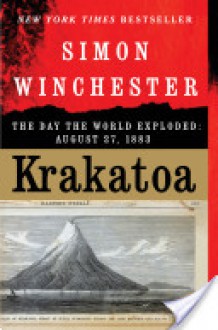
[Still reading children's books. Why we have them around is covered in this review. Short version: children's reading program, public schools.]
Oddly I'd read about this book before I realized there was a copy lying around here. In the book Krakatoa: The Day the World Exploded, August 27, 1883 (link to my vague review of mostly quotes) by Simon Winchester, this book is mentioned in the chapter called Recommendations for (and, in One Case Against) Further Reading and Viewing. It's not one that Winchester is recommending you avoid, if you were curious. But he does give a plot summary, and I am lazy so I'll quote. (The fact that I have the book handy is another reason to do this. It's rare that this happens.) So um, spoilers?
p 386: ...a slim volume of a children's book, published to near-universal praise in 1947...
...The children's story was The Twenty-One Balloons by William Pene du Bois: it won America's reknowned Newbery Medal in 1948, and has never been out of print since. It tells the story of a math teacher from San Francisco named William Waterman Sherman, who flies in a balloon westward across the Pacific, crash-landing (after seagulls pecked holes in the silk fabric) on what turns out to be "the Pacific island of Krakatoa." Here the impeccably dressed locals are all fabulously rich, since the volcano in the island's center sits directly on top of an immense diamond mine.
The resulting story is all about the professor's adventures among the remarkable people of a utopia, which, because of the eruption of 1883, swiftly becomes a dangerous dystopia. All have to flee in a specially built balloon-lifted platform. The book - 180 pages, endearing, illustrated by its thirty-year old author - is enchanting; most intelligent children will have read it, and they will in consequence know Krakatoa as, at the very least, a place both dangerous and beautiful, and wondrously exotic.
Winchester then goes on to discuss the movie to avoid, unless you enjoy bad films: Krakatoa, East of Java, directed by Bernard Kowalski, who is also to blame responsible for Night of the Blood Beast and Attack of the Giant Leeches. (I've seen the leech film, and possibly the Blood Beast. I'm not entirely sure because I slept through it, which is sad seeing that it's the MST3K version.) Krakatoa was never east of Java by the way - it's to the west.
If you want a much more through plot description, here's a really lengthy one:
Wikipedia: The Twenty-One Balloons
The story reminded me a lot of Jules Verne, and I'm pretty sure the reader is meant to think that. It refers to Around the World in Eighty Days in the book itself - but it's attitudes toward exploration of unknown lands and fabulous adventure, not to mention balloons, are all hat-tips to Verne.


 Log in with Facebook
Log in with Facebook 










